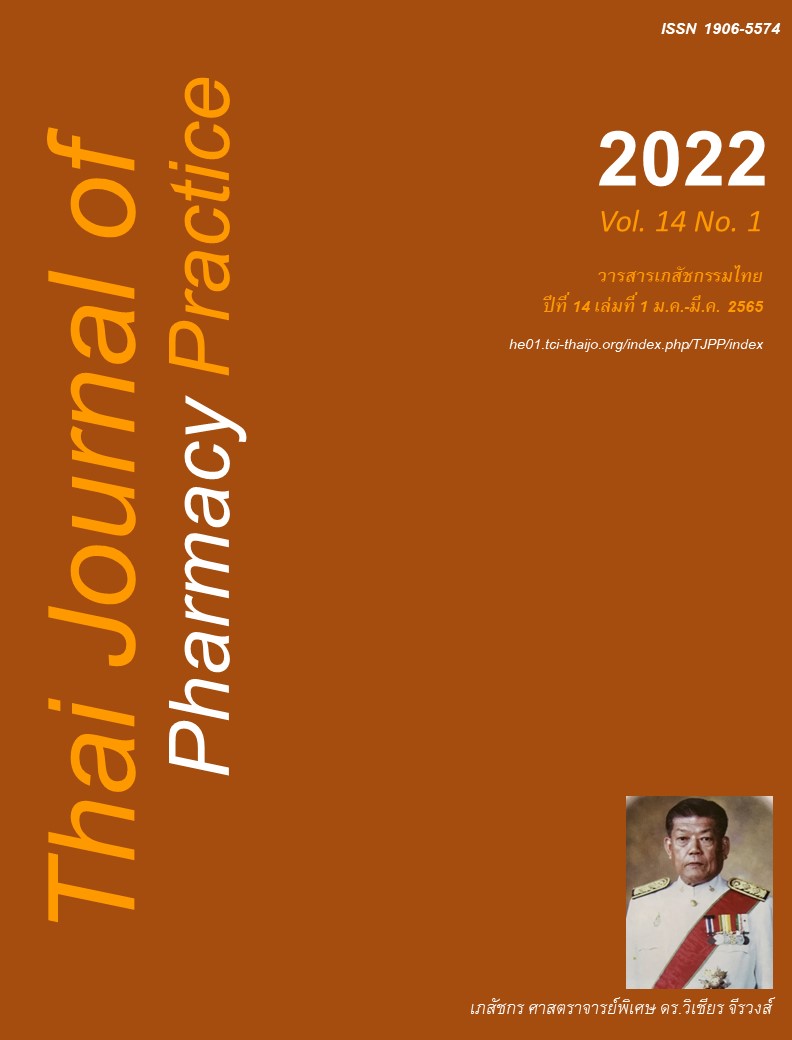บทบาทที่เป็นจริงในปัจจุบันและบทบาทที่พึงประสงค์ของเภสัชกร ต่อการปฏิบัติงานทางเภสัชกรรมในผู้ป่วยล้างไตทางช่องท้อง
Main Article Content
บทคัดย่อ
วัตถุประสงค์: เพื่ออธิบายบทบาทที่เป็นจริงในปัจจุบัน และระบุบทบาทที่พึงประสงค์ของเภสัชกรต่อการปฏิบัติงานทางเภสัชกรรมในผู้ป่วยโรคไตเรื้อรังที่ได้รับการล้างไตทางช่องท้อง วิธีการ: การศึกษานี้เป็นการวิจัยเชิงคุณภาพที่เก็บข้อมูล โดยการสัมภาษณ์ผู้ให้ข้อมูลหลักทั้งหมด 29 คน แบ่งเป็นผู้ให้ข้อมูลหลักจากโรงพยาบาลมหาราชนครราชสีมาและโรงพยาบาลอุดรธานี จำนวน 26 คน ได้แก่ อารยุรแพทย์โรคไต 8 คน พยาบาล 6 คน และเภสัชกร 12 คน รวมถึงการสัมภาษณ์ผู้ทรงคุณวุฒิที่เป็นเภสัชกร 3 ท่าน ผู้วิจัยวิเคราะห์เนื้อหาโดยใช้โปรแกรม ATLAS.ti Version 8.4.18 ผลการวิจัย: บทบาทที่เป็นจริงในปัจจุบันของเภสัชกรฯ มี 6 บทบาท ได้แก่ บทบาทการบริหารจัดการ บทบาทการวิจัย บทบาทการจัดหายาและการจัดการ ด้านการคลัง บทบาทการดูแลผู้ป่วย บทบาทการส่งมอบยา และ บทบาทการประเมินผลและติดตามผลการดำเนินงาน บทบาทที่พึงประสงค์มี 7 บทบาท โดยมีบทบาทการเตรียมยาเพิ่มเติมจากบทบาทที่เป็นจริงในปัจจุบัน สรุป: การปฏิบัติงานทางเภสัชกรรมในผู้ป่วยโรคไตเรื้อรังที่ได้รับการล้างไตทางช่องท้อง ไม่ได้มีเพียงบทบาทการดูแลผู้ป่วยเท่านั้น แต่ยังมีบทบาทอื่นเข้ามาเกี่ยวข้อง ทุกบทบาทมีการประสานความร่วมมือกันจากเภสัชกรหลายคน จากงานทั้งหมดของเภสัชกรที่รับผิดชอบต่อการใช้ยาในการรักษาผู้ป่วยทำให้สรุปได้ว่าบทบาทในการปฏิบัติงานด้านนี้ คือ บทบาทการบริหารจัดการระบบยาในผู้ป่วย ล้างไตทางช่องท้อง ผลการศึกษาสามารถนำไปใช้พัฒนางานเภสัชกรรมในผู้ป่วยล้างไตทางช่องท้องต่อไป
Article Details
ผลการวิจัยและความคิดเห็นที่ปรากฏในบทความถือเป็นความคิดเห็นและอยู่ในความรับผิดชอบของผู้นิพนธ์ มิใช่ความเห็นหรือความรับผิดชอบของกองบรรณาธิการ หรือคณะเภสัชศาสตร์ มหาวิทยาลัยสงขลานครินทร์ ทั้งนี้ไม่รวมความผิดพลาดอันเกิดจากการพิมพ์ บทความที่ได้รับการเผยแพร่โดยวารสารเภสัชกรรมไทยถือเป็นสิทธิ์ของวารสารฯ
เอกสารอ้างอิง
Ingsathit A, Thakkinstian A, Chaiprasert A, Sangtha wan P, Gojaseni P, Kiattisunthorn K, et al. Preva lence and risk factors of chronic kidney disease in Thai adult population: Thai SEEK study. Nephrol Dial Transplant 2010; 25: 1567-75.
Murray CJL, Lopez AD, Naghavi M, Wang H. Global, regional, and national life expectancy, all-cause mortality, and cause-specific mortality for 249 causes of death, 1980–2015: a systematic analysis for the Global Burden of Disease Study 2015. Lancet 2016; 388: 1459–544.
Hill NR, Fatoba ST, Oke JL, Hirst JA, O’Callaghan CA, Lasserson DS, et al. Global prevalence of chronic kidney disease–A systematic review and meta-analysis. PLoS ONE 2016; 7: 1-18.
National Health Security Office. National health security fund handbook year 2017 [online]. 2017 [cited Jul 12, 2020]. Available from: www.nhso. go.th.
Vadcharavivad S. Pharmacotherapy in chronic kidney disease. Bangkok: Text and Journal Publication; 2017.
Wankul S. Effect of pharmacist participation in patient care team for continuous ambulatory peritoneal dialysis (CAPD) patients. Thai Journal of Hospital Pharmacy 2012; 22: 115-22.
Chuemongkon W, Sukyoo P, Kruetiwa N. The effects of medication counseling on drug compliance in peritoneal dialysis patients at peritoneal dialysis clinic in Nopparat Rajathanee Hospital, Bangkok. Isan Journal of Pharmaceutical Sciences 2014; 10: 339-53.
Wetphakin K, Ngamkham J. The impact of pharmaceutical care to the quantity and cost of unused medication in end-stage renal disease patients undergo hemodialysis and peritoneal dialysis. Thai Journal of Hospital Pharmacy 2017; 27: 67-77.
Wattanaphan C, Pitak P, Methachaiwiwat T. Assess ments of pharmaceutical care in continuous ambula tory peritoneal dialysis clinic in nan hospital. Clinical Pharmacy Journal 2017; 23: 21-8.
Lindberg M, Lindberg P, Wikstrom B. Medication discrepancy: A concordance problem between dialysis patients and caregivers. Scand J Urol Nephrol 2007; 41: 546-52.
Njeri LW, Ogallo WO, Nyamu DG, Opanga SA, Birichi AR. Medication related problems among adult chronic kidney disease patients in a sub‑Saharan tertiary hospital. Int J Clin Pharm 2018; 40: 1217-24.
Griva K, Lai AY, Lim HA, Yu Z, Foo MWY, Newman SP. Non-adherence in patients on peritoneal dialysis: A systematic review. PLoS ONE 2014; 9: 1-11.
Geldine CG, Bhengu B, Manwere A. Adherence of adult chronic kidney disease patients with regard to their dialysis, medication, dietary and fluid restriction. Res J Health Sci 2017; 5: 3-17.
Hepler CD, Strand LM. Opportunities and responsi bilities in pharmaceutical care. Am J Hosp Pharm 1990; 47: 533-43.
Strand LM, Cipolle RJ, Morley PC. Pharmaceutical care: An introduction. Michigan: Upjohn Company; 1992.
Cipolle RJ, Strand LM, Morley PC. Pharmaceutical care practice: The clinician’s guide. 2 nd ed. New York: McGraw-Hill Companies; 2004.
Salgado TM, Moles R, Benrimoj SI, Fernandez-Llimos F. Exploring the role of renal pharmacists in outpatient dialysis centers: a qualitative study. Int J Clin Pharm 2012; 34: 569–78.
Jennifer AB, Rose MB, Cyndy AC, Sandra FD, Kelly TE, Laurel MM, et al. ASHP guidelines: Minimum standard for ambulatory care pharmacy practice. Am J Health-Syst Pharm 2015; 72: 1221-36.
Stemer G, Lemmens-Gruber R. Clinical pharmacy activities in chronic kidney disease and end-stage renal disease patients: a systematic literature review. BMC Nephrology 2011; 35: 1-12.
Mateti UV, Nagappa AN, Attur RP, Nagarapu SP, Rangaswamy D. Impact of pharmaceutical care on the health-related quality of life among hemodia lysis patients – A multicenter randomized controlled study. Saudi J Kidney Dis Transpl 2017; 28: 1293-306.
Al-Abdelmuhsin L, Al-Ammari M, , Babelghaith SD, Wajid S, Asiri YA , Almetawazi MS, et al. Pharmacist-led medication counseling for patients undergoing hemodialysis: A path to better adherence. Int J Environ Res Public Health 2020; 17: 1-9.
Management Science for Health. MDS-3: Managing Access to medicines and health technologies [online]. 2012 [cited May 7, 2020]. Available from: www.msh.org/resources/mds-3-managing-access-to-medicines-and-health-technologies.


